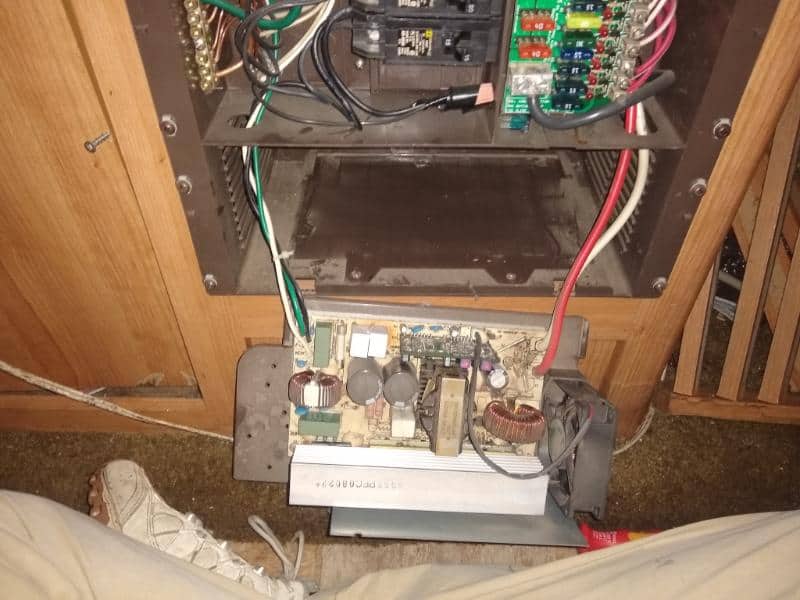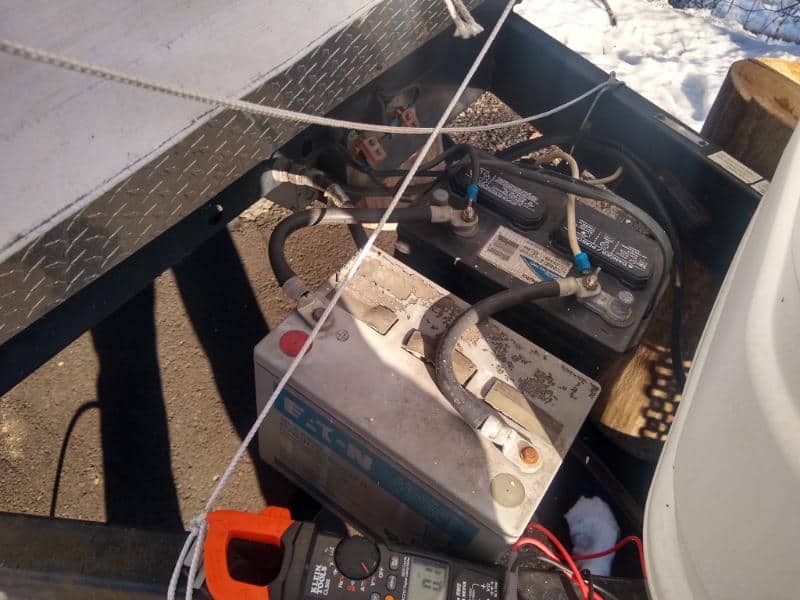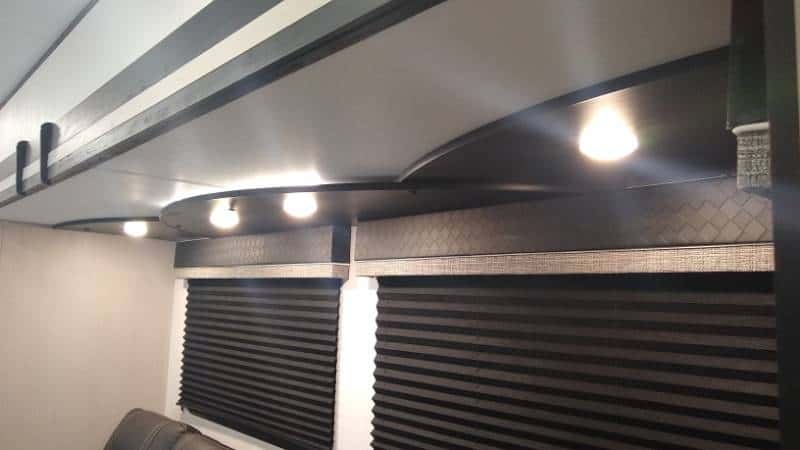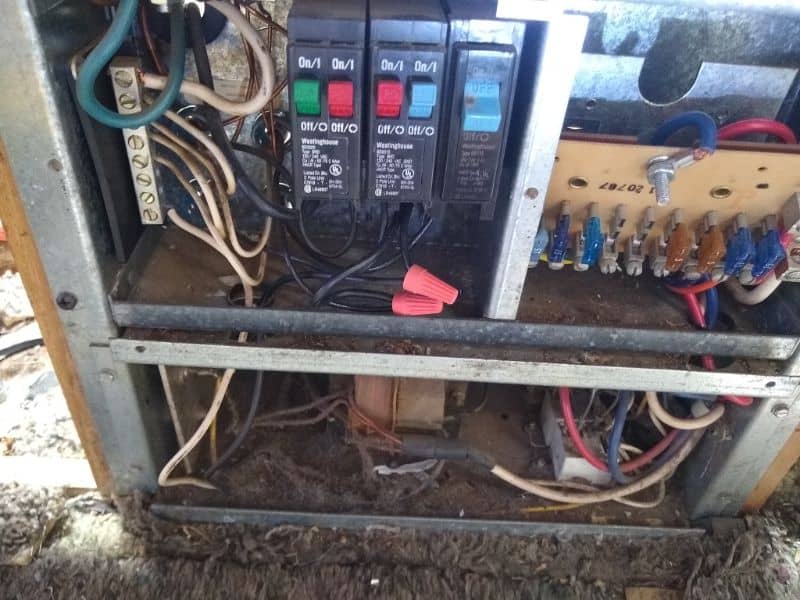Contrary to what the rest of the internet may tell you, RV converters are rarely fixable. In fact, some manufacturers design their converters specifically so they are not serviceable in the field (looking at you, WFCO). They either work, or they don’t. If your converter is dead or dying, you will need to unceremoniously divorce it for a newer, younger, better, version. But before you spend $200-$300 on a new converter, you should confirm your diagnosis.
Why Do RV Converters Die?

RV converters convert 120-volt alternating current electricity into 12-volt direct current electricity. DC electricity is used to power your lights, water pump, TV, furnace, and other light-duty loads.
This conversion process is never 100% efficient; some of the energy is dissipated as heat, and heat kills electrical components. Over time, the components degrade. There are other culprits as well: condensation, mice, beetles, dust, and dander. RV converters can die for multiple reasons, but eventually, nature will reclaim her own.
An RV converter should last 10-30 years. Full-time use or bad batteries can kill them faster. Unfortunately, some converters, like the WFCO 8955 converter, are known for dying pretty quickly. Don’t skimp on a replacement. If you’re clever with wiring, you can replace a power center converter with a deckmount converter and vice versa.
>>> READ MORE: RV 101: Intro to the Electrical System
Signs that an RV Converter Is Failing
Exact numbers depend on the converter (check your Owner’s Manual!), but most converters will output 13.2-13.6 volts during regular use. A failed converter will not.
Unfortunately, detecting the failure can be difficult. Sometimes, a converter will kick the bucket and refuse to output any voltage. Other times, they’ll weaken over time; they’ll be able to supply 13.2 volts with minimal loads, but the output voltage will drop with bigger loads (like a furnace or refrigerator). Still other times, the output voltage might fluctuate; it might drop to 10 volts; it might drop to 4.2 volts. Failure might be instantaneous …. or it might be intermittent. Good luck!
>>> READ MORE: If You Buy an RV Lithium Battery, You’ll Need a Converter to Go With It!
A failed RV converter will generally cause low DC system voltage. Low voltage will cause appliance error codes, flickering lights, and other faults. Many propane-fired appliances won’t operate at less than 10.5 volts. Other appliances, like LP/CO detectors, will display error codes at low voltages.
Symptom 1: Battery Is Constantly Dying

If your RV house batteries are constantly dying, but they pass a battery load test, then that’s an indication they aren’t being charged by your converter. I wrote an entire diagnostics article about why your multi-stage converter isn’t charging your battery, but you can start with a simple test.
- Plug your RV into shore power.
- Grab a volt meter.
- Access your house batteries.
- Test the DC voltage between the main positive and negative battery cables.
The voltage should be either 13.2-13.6 volts (Float or Absorption Mode). If you disconnect the power cables from the batteries and wait a few minutes, then the voltage across the disconnected cables should be 14.0-14.4 volts (Bulk Mode).
If you’re seeing 0 volts, fluctuating voltages, or anything below 13 volts, that’s a definite sign that either A) your converter is failing, B) there’s some bad wiring between your converter and your battery, or C) there’s a manual or electronic disconnect switch that has somehow disconnected your battery from your converter.
Symptom 2: You Can’t Hear the Cooling Fan

All converters dissipate some heat. Therefore, all converters come with a cooling fan. Some are temperature-controlled, some are load-controlled. Most of these cooling fans make a little noise while running, just like a computer cooling fan. They will cycle on and off as needed. If you never hear the cooling fan while the converter is running, that’s a sign of a dead or dying converter.
If you don’t know where your converter is … well, they can be just about anywhere! But usually, they are close by your circuit breaker box. Sometimes, they are directly behind the breaker box and inaccessible unless you remove the breaker box first.
Symptom 3: Error Codes, Dimming Lights

Low DC system voltage in an RV will usually manifest itself as
If you notice flickering or dimming interior lights, either your converter or battery (or both) is failing. To check if your converter is the problem, disconnect the house batteries via the battery disconnect switch or by removing the battery cables from the battery terminals. If the flickering or dimming continues, that means your converter can’t output consistent DC voltage. You can verify this with an analog or digital volt-meter.
ALERT. This problem might only show up in certain situations! Your converter may be “strong” enough for light use but shows its “weakness” when under load, such as running your water pump and furnace simultaneously.
>>> READ MORE: Why Are My RV Lights Flickering or Dimmering?
… Are You Sure It’s the Converter?
Sometimes, another electrical problem can masquerade as a failing converter.
- Your converter is powered by an AC branch circuit protected by a circuit breaker. If this circuit breaker gets old and weak, it’ll trip before delivering full power to the converter. The converter might shut down when trying to recharge a fully dead battery, for instance.
- Most converters have a feature called “electronic current limiting” where output voltage will drop if you exceed the amperage rating of the converter. In this case, low voltage isn’t a fault; it’s a protective feature.
- Disconnect batteries before pronouncing the final cause of death. A shorted battery cell can cause the converter to work too hard, which will drop the voltage (see reason above).
- If you have a separate deckmount converter, it probably has two 40 or 50-amp ATC fuses. If these fuses blow, the converter won’t work. Replace these fuses; they cost $0.10 each.

To be honest, diagnosing a dead or dying RV converter isn’t that difficult. If you remove the RV house batteries from the equation and your 12V system isn’t being supplied with correct low-voltage power, you either have a bad converter or a wiring problem. A little diagnostics with a multimeter at the DC fuse panel and AC panelboard will usually isolate the culprit. If you need a replacement, trust a well-known brand like PowerMax, Iota, or Progressive Industries.
Hint: Emergency? Make Do with the “Poor Man’s Converter”
If you’ve determined that you have a failed converter but you’re in the middle of a camping trip, here’s a non-authorized, redneck “poor man’s converter.”
Purchase a 3-stage electronic battery charger capable of outputting at least 10-15 amps at 12-volts. Attach the battery charger to the battery terminals and plug it in. Even if the batteries can’t hold a charge, the low-voltage electrical system can draw 12-volt power straight from the charger. Again, this isn’t kosher, and I only recommend it as an emergency band-aid for a few days at most.
Hint: Choose the Brand You Want
You aren’t married to the OEM’s choice of converter forever. Even a power center converter, like the ever-popular WFCO 8955, can be orphaned and bypassed with a separate deckmount converter. It’s your choice! PowerMax, Boondocker, Progressive Industries, Iota Engineering – take your pick. BestConverter.com is one of my favorite online resources; much better than Amazon!
WARNING: Don’t Trust Google for Your Failing RV Converter Troubleshooting!
Can I rant for a minute?
When I write a post for this website, I usually review the top 10 search engine results. I want an eagle-eye’s view of what people are asking, what’s being provided, and where the information gaps are.
On behalf of the entire internet, I want to apologize. There is just so much crummy, scummy misinformation out there nowadays. With the cloudburst in RV popularity has sprouted a crop of SEO-optimized, AI-driven websites that do nothing but chew up and spit out content scraped and stirred from around the web.
This article from the so-called Camping Advisor was particularly egregious, and I’m pretty sure a human has never touched it. Here’s my favorite line:
“Faulty resistors- some converters still use these components. If they go bad, then the converter won’t work right. A multimeter is needed to check to see if they are faulty or not. You will want to have a reading between 3 and 13 volts for the resistor to be okay. These parts are a little difficult to replace due to their construction and placement.”
Actually … every single RV converter uses resistors, dozens of them, since they are integrated into the printed circuit control board (PCB). But you have no way of knowing what the design voltage drop is, and unless you’re an electronics soldering expert, you won’t be replacing any of them, anyway. Plus, most RV converters cannot be serviced in the field. If you go poking around insid an RV converter, you’re likely to get yourself shocked from a stray capacitor. And if the converter wasn’t already damaged, it probably will be!
Here’s another crummy troubleshooting article from Outdoor Fact full of potentially dangerous misinformation:
“When the converter is connected to the power supply, check the voltage at the point of entry. If the voltage stays anywhere between 108V and 130V, the converter is probably OK. Next, you have to check the voltage where the converter is connected to the breaker box. If the voltage is around 11V – 13V, then the converter is totally fine. A bad converter would have a voltage below that.”
Where do I begin? If your incoming A/C line-to-neutral voltage is 130 volts, you need to unplug your RV and find out what’s going on with the power grid, not your RV! And if the output voltage from the converter is less than 13 volts, that’s a failed/failing converter. Full stop. No normal RV converter is going to output less than 13.0 volts.
Just because the content is written by a recognizable brand is no guarantee, either. Here’s another rotten egg from Cruise America:
“Connect the DMM to the panel. Finally, you’ll see if the converter is properly changing the power from AC to DC. If the meter reads between 12.3 to 12.9 volts, it means the converter is working properly. Anything less or more, and you may need to do some troubleshooting.”
Again, if your converter is putting out 12.3-12.9 volts, you have a problem. A lead-acid battery may be fully charged at 12.8 volts, but that’s not the correct output voltage for any RV converter I know of! Such a “weak” converter may drop under heavy demand from a furnace, water pump, or other 12V electrical loads.
This isn’t a sales pitch for my own website. I run a small website, and I don’t answer every single technical RV question. There are many other great educational resources, such as Mike Sokol’s RV Electricity, Gary Bunzer’s “The RV Doctor”, My RV Works, AZ Expert, and NRVTA’s Tech Tip Tuesday. Just be careful where you get your information from, ok?
Leave a Reply